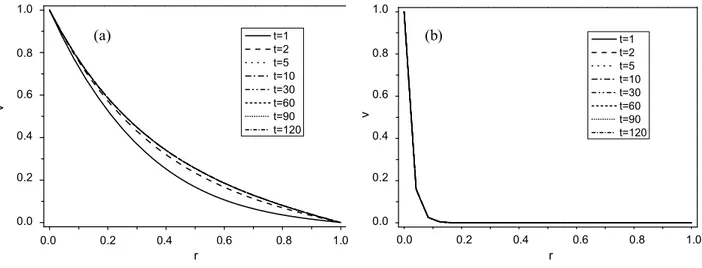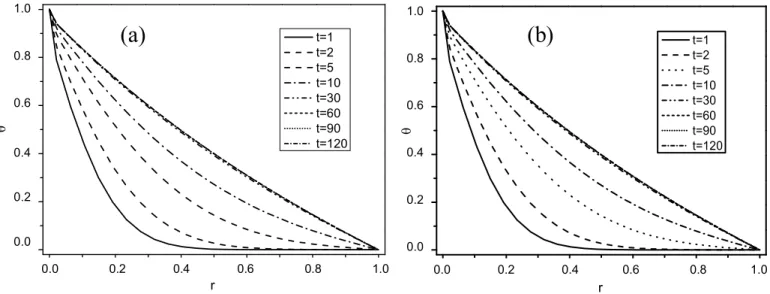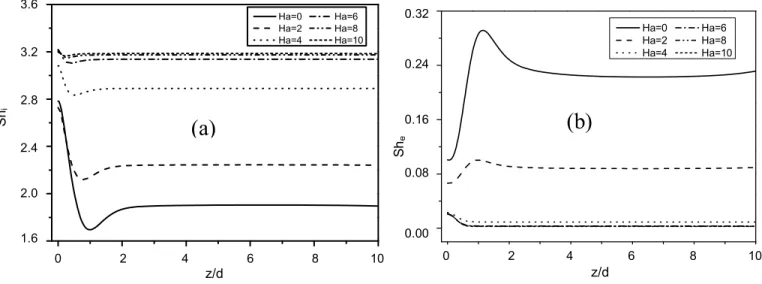Effect of an axial magnetic field on the heat and mass transfer in rotating annulus
Texte intégral
(2) Aberkane et al.. investigated in several pieces of literature. However, to the author’s knowledge a few studies have been conducted on double-diffusive convection in a rotating annulus in the presence of a magnetic field. Recently, the effect of magnetic field on the laminar convection in either vertical or horizontal rotating concentric annuli has been investigated. Ben and Henry. (1996) investigated numerically the effect of a constant magnetic field on a three-dimensional buoyancy-induced flow in a cylindrical cavity, they put in light the structural changes of the flow induced by the magnetic field for each field orientation. Singh et al. (1997) presented exact solutions for fully developed natural convection in open-ended vertical concentric annuli under a radial magnetic field. El Amin (2003) studied the effects of both first- and second-order resistance due to the solid matrix on forced convective flow from a horizontal circular cylinder in the presence of a magnetic field and viscous dissipation, with a variable surface temperature boundary condition. Hayat and Kara (2006) investigated the Couette time-dependent flow of an incompressible third-grade fluid subjected to a magnetic field of variable strength analytically. Group theoretic methods were employed to analyze the nonlinear problem and a solution for the velocity field was obtained analytically. Sankar et al. (2006) studied numerically a natural convection of a low Prandtl number electrically conducting fluid under the influence of either axial or radial magnetic field in a vertical cylindrical annulus. They showed that the magnetic field can be suppress the flow and heat transfer. Bessaïh et al. (2009) studied the MHD stability of an axisymmetric rotating flow in a cylindrical enclosure containing liquid metal (Pr = 0.015), with an aspect ratio equal to 2, and subjected to a vertical temperature gradient and an axial magnetic field. Azim et al. (2010) studied numerically the effect of magnetic field and Joule heating on the coupling of convection flow along and conduction inside a vertical flat plate in the presence viscous dissipation and heat generation. Ellahi et al. (2010) determined analytic solutions for a nonlinear problem governing the MHD flowof a third grade fluid in the annulus of rotating concentric cylinders. Makinde and Onyejekwe (2011) investigated a steady flow and heat transfer of an electrically conducting fluid with variable viscosity and electrical conductivity between two parallel plates in the presence of a transverse magnetic field. Kakarantzas et al. (2011) studied numerically the combined effect of a horizontal magnetic field and volumetric heating on the natural convection flow and heat transfer of a low Prandtl number fluid in a vertical annulus. Seth et al. (2011) studied the effects of rotation and magnetic field on unsteady Couette flow of a viscous incompressible electrically conducting fluid between two horizontal parallel porous plates in a rotating medium. Mozayyeni and Rahimi (2012) investigated numerically the problem of mixed convection of a fluid in the fully developed region. 369. between two horizontally concentric cylinders with infinite lengths, in the presence of a constant magnetic field with a radial MHD force direction, considering the effects of viscous heat dissipation in the fluid in both steady and unsteady states. Seth and Singh (2013) studied theoretically the effect of Hall current and a uniform transverse magnetic field on unsteady MHD Couette flow of class-II in a rotating system. Takhar et al. (2003) studied the unsteady mixed convection flow over a rotating vertical cone in the presence of a magnetic field. Recently, some attention has been paid by Ashorynejad (2013) to the effect of magnetic field convection on natural convection heat transfer in a horizontal cylindrical annulus enclosure filled with nanofluid using the Lattice Boltzmann method. Also Sheikholeslami et al. (2013) solved the problem of heat and fluid flow of a nanofluid in a half-annulus enclosure with one wall under constant heat flux in presence of magnetic flied using control volume based finite element method. In another publication Sheikholeslami et al. (2014) applied Lattice Boltzmann Method to simulate the effect of magnetic field on free convection of nanofluid, in an eccentric semiannulus. In a recent paper Aminfar et al. (2014) experimentally studied the effects of using magnetic nanofluid and also applying an external magnetic field on the critical heat flux of subcooled flow boiling in vertical annulus. Some surveyed studies in the literature were concerned primarily with the double diffusive convection, Teamah (2007) carried out a numerical study of double-diffusive laminar mixed convection within a two-dimensional, horizontal annulus rotating cylinders. The results for both average Nusselt and Sherwood numbers were correlated in terms of Lewis number, thermal Rayleigh number and buoyancy ratio. Moreover, Molki et al. (1990) applied the naphthalene sublimation technique to an annulus with a rotating inner cylinder in order to study heat transfer in the entrance region to obtain heat transfer data for laminar flows and compare them with results of mass transfer. Kefeng and Wen-Qiang (2006) simulated numerically the characteristics of transient double-diffusive convection in a vertical cylinder using a finite element method. Recently, Venkatachalappa et al. (2011) carried out numerical computations to investigate the effect of axial or radial magnetic field on the double-diffusive natural convection in a vertical cylindrical annular cavity. Although the exact solutions for the Hartmann flow and the MHD Couette flow have been achieved for more than seventy years, the solutions for a heat transfer in flow between concentric rotating cylinders, also known as Taylor Couette flows, under external magnetic field have been restricted to high Hartmann numbers. The aim of the present study is to examine analytically and numerically the effects of an external axial magnetic field applied to the forced convection flow of an electrically conducting fluid between two horizontal.
(3) 370. Int. J. Phys. Sci.. 2. k T v v r r r r r r . (2). r r1 : v(r) 1r1 , T T1. (3). r r2 : v(r) 2 r2 ,T T2. (4). The governing equation and boundary conditions, Equations (1) to (4), which are in non-adimensional form, become: Figure 1. Geometry of the problem. 2 v* r. concentric cylinders, considering the effects of viscous heat dissipation in the fluid. Also we investigated numerically the effects of the magnetic field on the mass transfer in the annular cavity. It should be noted that the natural convection is supposed negligible in this work, which is not always the case of the vertical cylinder. The forced flow is induced by the rotating inner cylinder, in slow constant angular velocity and the other is fixed.. *. 2. * v 0 . v* v* 1 * r Ec Pr * * r* r* r* r r. (5). 2. (6). r * : v* (r * ) 1, 1. (7). r * 1 : v* (r * ) b, 0. (8). Where. r , * v , r1 , 2r2 , , TT2 , Pr , Ec 1r1 v b Ha Bd 0 CpT a r2 T1 T2 1r1 r2 1r1 2. FORMULATION OF THE PROBLEM. r* . Consider a laminar flow of a viscous incompressible electrically conductive fluid between two coaxial cylinders. The inner cylinder of radius r1 is rotated at a constant speed Ω1 and the outer cylinder of radius r2 is kept fixed. The inner and outer walls are maintained at a constant and different temperatures and concentrations, but their values for the inner are higher than the outer, while the top and bottom walls are insulated and impermeable. The two cylinders are electrically isolated. The flow is subjected to a constant uniform and axially magnetic field B0. Geometry of the problem is presented in Figure 1. We assume that the magnetic Reynolds number is neglected. When the magnetic field is uniform and externally applied, its time variations can be neglected and the set of flow equations further simplified to involve only the NavierStokes equations and the conservation of the electric current. Also we assume that the electric field is zero. In this study the viscous dissipation term in the energy equation is considered.. Where, the stars are dropped for convenience. The velocity profile in the annular space is obtained by solving the Equation (5) as follows:. Ha Ha v r CI r C2K1 r 0 1 1 1 1 . The flow is assumed to be steady, laminar and unidirectional, therefore the radial and axial components of the velocity and the derivatives of the velocity with respect to θ and z are zero. Under these assumptions and in cylindrical coordinates, the governing equations for the flow following the azimuthal direction can be written as follows:. (1). (9). Where:. M. Ha 1 . C1 and C2 are the constants of integration, which are determined from the boundary conditions on the velocity.. C1 . ANALYTICAL STUDY. 2 v 1 v v vB02 2 2 0 r r r r . 2 1 v* Ha 1 2 * * r r 1 2 r *. . C2 . K1 M bK1 M. I1 M K1 M K1 M I1 M bI1 M I1 M. I1 M K1 M K1 M I1 M. I1 is the modified Bessel function of the first kind of order 1, and K1 is the modified Bessel function of the second kind of order 1. To obtain the temperature field from Equation (6), we performed calculations by using the expansions with three terms of the modified Bessel functions I1 Mr and K1 Mr used by Omid et al. (2012), for small values of Ha. It can be used as following:.
(4) Aberkane et al.. Mr Mr 1 I1 (Mr) Mr 2 16 384 3. K1 (Mr) . The solution of the energy equation is:. 5. 1 1 Mr 1 ln( ) (2 1) (Mr) Mr 2 2 4 . 1 5 1 Mr ln( ) ( 2) (Mr)3 16 2 32 2 . (10). (11). Where γ is Euler's constant defined by:. 1 1 1 1 lim 1 ..... ln(m) x m 2 3 4 0,5772156649.... C10 . expansions in the velocity equation, Equation (9), and using the new velocity distribution in Equation (6) to find the temperature field. The temperature gradient is given then by the following equation:. 11 1 1 C12 C1C2 C2 2 2304 192 192. 11 7 1 2 1 2 125 2 1 C6 C22 CC C2 C1 C2 CC 1 2 1 2 2304 2304 384 384 55296 192. 1 7 1 C7 C 2 2 C 2 2 C1C 2 4 16 4. C8 . 1 1 1 C 2 2 C 2 2 C1C 2 32 32 48. 7 1 1 C9 C1C2 C1C2 C12 24576 3072 3072. (13). (12). 1 1 1 C5 C 6 C2 2 36 6 41472. 1 1 C11 C9 C1C 2 8 196608. C12 . Where the constants C5 to C9 are given in terms of C1 and C2 as follows:. C5 . 1 2 10 6 8 4 1 2 C10 Mr C11 Mr C12 Mr 2C7 Mr 921600C1 Mr 2 2 Mr 2 Mr C22 1 r 6 M C2 ln 2C2 ln 2 C5 Mr ln 2 2 6 2 Mr C4 C3 ln(r)Br 2 1 2 6 Mr 1 2 6 Mr 6 C M r C M r ln C M r ln 2 2 6 2304 2 2 6912 1 2 4 Mr 1 8 Mr CC r ln 1 2M C2 Mr ln 2 2 24576 128 Where the Constants C10, C11 and C12 are given as follows:. By substituting the values of I1 Mr and K1 Mr from the above. 2 Mr 2C22 6 Mr 2C2 ln 2 2 C5 Mr ln 2 M r 2 2 1 Mr 6 6 2 C6 Mr C2 Mr ln 384 2 C3 Br 1 2 4 4 Mr C7 Mr C8 Mr C22 Mr ln r r r 32 2 1 Mr 8 8 C Mr 9 3072 C1C2 Mr ln 2 1 C 2 Mr 10 92160 1 . 371. 1 1 C8 C22 4 512. NUMERICAL STUDY In this numerical study, we consider two-dimensional and axisymmetric unsteady flow. We opted for the velocity - pressure formulation due to its rapidity of prediction, its lower cost, and its ability to simulate real conditions. The finite difference scheme adopted for the resolution is very similar to that used by Peyrret (1976), and Ghezal and Porterie. (2011), this is a semi implicit scheme of Crank-Nicholson type, iterative process based on the perturbation of the continuity equation by introducing an artificial compressibility. The spatial discretization using the marker and cell (MAC) is shown in Figure 2. The iterative procedure is assumed converged when the following test is verified. max( Lu , Lv , Lw , L , LC D) where Lu, Lv, Lw, Lθ, LC and D represents operators differences relating to system equations corresponding to the problem variables u, v, w, θ, C and Π respectively, ε is of the order of 10-5 depending on the considered case. We then proceeded to a study of the mesh sensitivity of the field of study. This study led us to retain a mesh of 336 nodes along the direction r and 48 nodes in the z direction.. Mathematical equations Based on these dimensionless variables, the conservation equations of mass, momentum and energy are written in non rotating frame cylindrical coordinates as follows (where the stars are dropped for convenience):.
(5) 372. Int. J. Phys. Sci.. Vni-1/2,j+1/2 Tni-1/2,j+1/2 Cni-1/2,j+1/2. Uni,j+1/2. Wni-1/2,j. Vni+1/2,j+1/2 Tni+1/2,j+1/2 Cni+1/2,j+1/2. Nu e (z) With:. Wni+1/2,j. Πi,j. n. n. U. V i+1/2,j-1/2 Tni+1/2,j-1/2 Cni+1/2,j-1/2. i,j-1/2. z. 1 Nu i Nu i (z)dz L0 z. Figure 2. M.A.C cell.. Nu e . u u w 0 r r z. Similarly, we can calculate both local Sherwood number as follows:. (15). v v vu v 1 2v 1 v 2v v Ha2v u w t r r z Ta r2 r r z2 r2 1 Ta. (16). w w w 1 2 w 1 w 2 w u w 2 t r z z Ta r 2 r r z . (17). 1 2 1 2 1 Ec u w t r z Pr Ta r 2 r r z 2 Ta. (18). 2. 2. 2. 1 2 C 1 C 2 C C C C u w ScTa r 2 r r z 2 t r z. Sh i (z) . C r r . Sh e (z) . C r r 1. Initial and boundary conditions At the time t=0:. u(r,z,0) v(r,z,0) w(r,z,0) (r,z,0) (r,z,0) C(r,z,0) 0 (19). (20). The boundary conditions are as follows:. r z 0 : u(r1,z) v(r1,z) w(r1,z) 0. Where: is the Hartmann number, Ha Bd . Ta . 1 Nu e (z)dz L 0. (14). u u v u 1 u 1u u u Ha u u w t r r z r Ta r2 r r z2 r2 1 Ta 2. 1 . The average Nusselt number on the inner and outer cylinders is given by:. n. V i-1/2,j-1/2 Tni-1/2,j-1/2 Cni-1/2,j-1/2. r r 1. 1 r1 d is the Taylor number, . r 1 z 0 : u(r2 , z) v(r2 , z) w(r2 , z) 0. Pr is the Prandtl number. (r2 , z)=C(r2 , z) 0. a Sc is the Schmidt number, D d r1 r2 is the width of the annular space,. r 1. z0:. u 2 u 2 w 2 u w 2 v v 2 v 2 2 is the viscous r r z z r r r z . zL:. u = v = w 0,. dissipation function. The rate of heat transfer in non – dimensional for the inner and outer cylinder is given by:. (21). (r1,z)=C(r1,z) 1. u v = w=0 ,. z. . C z. C z. 0. =. z. 0. (22). (23). (24). RESULTS AND DISCUSSION. Nu i (z) . r. r . In order to understand the physical situation of the problem and the effects of the Hartmann and Eckert numbers, we have found the numerical and analytical.
(6) Aberkane et al.. 4. 4. (a). (b). B1=-0.3 B1=0 B1=0.3. 3. Ha=0 Ha=4,9295. 3. 2 velocity. 2 velocity. 373. 1. 1. 0. 0. -1. -1 2. 4. 6. 8. 0,2. 10. 0,4. 0.2. 0,6. 0.4. 0.6. 0,8. 0.8. 1,0. 1.0. Radius. Radius. Radius. Figure 3. Velocity profile of the fluid in the annulus for b = -1, (a) Result of Dizaji Feiz et al. (2008), (b) Results of the present analytical study.. 1,0 1.0 Analytical Ha=0 Ha=2 Ha=4. 0,8 0.8. Numerical Ha=0 Ha=2 Ha=4. v. v. 0,6 0.6. 0.4 0,4. 0,2 0.2. 0.0 0,0 0,0 0.0. 0,2 0.2. 0,4 0.4. r. 0,6 0.6. 0,8 0.8. 1,0 1.0. r. Figure 4. Comparison of analytical and numerical results of velocity profile, for η = 0.5,b=0, Ta=20,t*=120.. values of the velocity, temperature, concentration, the Nusselt number and Sherwood number. The analytical method developed in the present work has been compared in Figure 3 with the results obtained by FeizDizaji (2008), for the velocity profiles of the fluid in the annulus of concentric cylinders with velocity ration b =-1. The results are found to be in good agreement except for the negative values of magnetic field B1 which cannot exist in our non- dimensional study, Hartmann number (Ha) is a strictly positive non-dimensional number. The results obtained through the developed code in FORTRAN based on an implicit finite-difference method. described earlier, are compared with those calculated using the analytical approach for small value of Hartmann number. The velocity, temperature and average Nusselt numbers are evaluated analytically and numerically for different values of Hartmann number in Figures 4, 5 and 6. Obviously, the velocity and temperature profiles, for various Ha obtained via these two different methods, agree with each other reasonably well. We can notice in Figure 4 that the velocity profile without magnetic field Ha=0 is quasi-linear, and an increase in Hartman number, which causes a reduction of the velocity in the annular space because the centrifugal force is counter- productive.
(7) 374. Int. J. Phys. Sci.. 1,0 1.0 Analytical Ha=0 Ha=0.4 Ha=0.8. 0,8 0.8. Numerical Ha=0 Ha=0.4 Ha=0.8. . . 0.6 0,6. 0.4 0,4. 0,2 0.2. 0,0 0.0 0,0 0.0. 0,2 0.2. 0,4 0.4. rr. 0,6 0.6. 0,8 0.8. 1,0 1.0. Figure 5. Comparison of analytical and numerical results of temperature profile, for η = 0.5, b=0, Ta=20, Pr = 0.02, Ec=0.5, t*=120.. ( ). 0,730 0.730. 1,434 1.434. (a). Analytical Numerical. (b). Nue . 0,729 0.729. 1,428 1.428. analytical Numerical. 0,728 0.728. 0.727 0,727. Nu e. Nui. 1,431 1.431. Nu i. 1.425 1,425. 0.726 0,726. 1.422 1,422. 0.725 0,725. 1.419 1,419. 0.724 0,724. 1,416 1.416. 0.723 0,723 0,0 0.0. 0,2 0.2. 0,4 0.4. Ha. 0,6 0.6. 0,8 0.8. 1,0 1.0. Ha. 0,0 0.0. 0,2 0.2. 0,4 0.4. Ha. 0,6 0.6. 0,8 0.8. 1,0 1.0. Ha. Figure 6. Comparison of analytical and numerical results of average Nusselt number on (a) inner and (b) outer surfaces of the cylinder against the Hartmann number, for η = 0.5, b=0, Pr = 0.02, Ec=0.5.. and the Lorentz electromagnetic force acts as a flow damper. It is observed from Figure 5 that the effect of weak magnetic field on the radial profile of temperature is insignificant for small value of Prandtl numbers (Pr=0.02) which is appropriate for liquid metal. It is valid in the case of low and high values of Hartmann number. Figure 6 displays the effect of Hartmann number on the average Nusselt number on inner and outer surfaces. As can be seen, from this figure that the analytic approach. corresponding to the expansion with three terms of the modified Bessel functions is closer to the numerical approach. The difference between the analytical and numerical values is approximately 10-3, even the results obtained from the present theoretical analysis are restricted to a one-dimensional flow and the numerical results are calculated using two-dimensional axisymmetric flow. Figure 7 shows the effect of Hartmann number on the local Nusselt number on the inner and.
(8) Aberkane et al.. 0,728 0.728. 1,44 1.44. (a) 0,727 0.727. 1,42 1.42. Ha=0 Ha=2 Ha=4. (b). 375. Ha=6 Ha=8 Ha=10. Nue Nue . 0.725 0,725. Nui. Nui. 0,726 0.726. 1,40 1.40. 1,38 1.38. Ha=0 Ha=2 Ha=4. 1.36 1,36. Ha=6 Ha=8 Ha=10. 0.724 0,724 0.723 0,723 0.722 0,722. 1.34 1,34 00. 22. 4 4. 6. 88. 6. z/d. 0 0. 10 10. 22. 4 4. z/d. z/d. 66. 8 8. 10 10. z/d. Figure 7. Effect of Hartman number on local Nusslet number distribution on (a) inner and (b) outer cylinders, for η = 0.5, Pr = 0.02, Ec=0.5, t*=120.. 0,728 0.728. 1,44 1.44. Ec=0 Ec=0.01 Ec=0.1. (b). 0,727 0.727. Ec=0.3 Ec=0.5. 0,726 0.726. Nui. Nue . 1.42 1,42. Nui. Nue. 0,725 0.725. Ec=0 Ec=0.01 Ec=0.1. 1.40 1,40. Ec=0.3 Ec=0.5. 0,724 0.724 0,723 0.723. 1.38 1,38. 0,722 0.722. (a). 1.36 1,36. 0,721 0.721 0,720 0.720. 0 0. 22. 4 4. z/d z/d. 6 6. 8 8. 10 10. 0. 2 2. 44. 6 6. 88. 10 10. 12 12. z/d z/d. Figure 8. Effect of Eckert number on local Nusselet number distribution on (a) inner and (b) outer cylinders, for η = 0.5, Pr = 0.02, Ha=0, t*=120.. outer surfaces, for an Eckert number Ec = 0.5. It is found that for high values of Hartmann number, the local Nusselt number on the inner and outer surfaces decreases. In fact when the Eckert number is considerable, the heat generation in the fluid increases because the viscous dissipation. Thus the temperature of the fluid in the annular space increases causing a decrease in the temperature gradient in the vicinity of the inner cylinder and an increase of the gradient in the vicinity of the outer cylinder. A significant increase in the Hartmann number causes a reduction of the centrifugal force, which results in a gradual decrease in the Nusselt number. It is worth to mention that this phenomenon is in full accordance with what was previously observed by Mozayyeni (2013) for a horizontal cylindrical annulus, also by El-Amin (2003) for horizontal cylinder in a porous medium and by Takhar et al. (2003). for rotating vertical cone.. The analysis of the variation of local Nusselt number on the inner and outer cylinder shows that this number tends to a limit value. It can be noticed that the Nusselt number on the outer cylinder is lower than on the inner cylinder, because the velocity and temperature gradient are higher for the cold inner cylinder than for the outer cylinder. It should be also noted that the effect of magnetic field on the temperature distribution is insignificant, whereas the changes induced by the magnetic field on the temperature gradient and therefore on the Nusselt number is considerable. Effect of Eckert number on the distribution of local Nusselt number on the inner and outer cylinders isdisplayed in Figure 8, for Ha = 0. As can be seen, with increase of Eckert number, the influence of heat transfer due to the viscous dissipation in the annular space is improved, which leads to the increase in the average temperature of the fluid at this region, especially near the.
(9) 376. Int. J. Phys. Sci.. 1.0 1,0. 1.0 1,0. (a). (b). t=1 t=2 t=5 t=10 t=30 t=60 t=90 t=120. v. v. 0,6 0.6. 0.4 0,4. t=1 t=2 t=5 t=10 t=30 t=60 t=90 t=120. 0,8 0.8. 0.6 0,6. vv. 0,8 0.8. 0.4 0,4. 0.2 0,2. 0.2 0,2. 0.0 0,0. 0.0 0,0 0,0 0.0. 0,2 0.2. 0,4 0.4. rr. 0,6 0.6. 0,8 0.8. 1,0 1.0. 0,0 0.0. 0,2 0.2. 0,4 0.4. rr. 0,6 0.6. 0,8 0.8. 1,0 1.0. Figure 9. Velocity distribution at different times at z/d=7 and for Ta=20, (a) Ha = 2 and (b) Ha = 50.. 1,0 1.0. 1,0 1.0. (a). (b). t=1 t=2 t=5 t=10 t=30 t=60 t=90 t=120. . . 0,6 0.6. 0,4 0.4. 0,8 0.8. 0,6 0.6. . 0,8 0.8. t=1 t=2 t=5 t=10 t=30 t=60 t=90 t=120. 0.4 0,4. 0.2 0,2. 0,2 0.2. 0.0 0,0. 0,0 0.0 0,0 0.0. 0,2 0.2. 0,4 0.4. r r. 0,6 0.6. 0,8 0.8. 1,0 1.0. 0,0 0.0. 0,2 0.2. 0,4 0.4. r. 0,6 0.6. 0,8 0.8. 1,0 1.0. r. Figure 10. Temperature distribution at different times for z/d=7, Ta=20, Ec=0, Pr=0.02, for (a)Ha = 2 and (b)Ha=50.. inner cylinder, to be more than in the past. The dimensionless temperatures of inner and outer cylinders are maintained at 1.0 and 0.0, respectively. It is evident that by increasing the average temperature of fluid in annular space, the rate of heat transfer between the fluid and inner cylinder decreases due to the reduction of the temperature difference between them. In contrast to the other case, the local Nusselt number on the outer cylinder increases as the Eckert number increases because of the enhancement of temperature differences between the fluid and the outer cylinder. In this part, some results are presented in different nondimensional time values for the distribution of velocity and temperature in the annulus Figures 9, 10, and 11. From Figure 10, we can notice that for a small value of. Prandtl number (Pr=0,02), The effect of the time variation is found to be not significant on the temperature, it reaches faster a steady-state to the point that we can’t notice the difference between the steady and unsteady states flows. As we know, for larger fluid Prandtl number, the momentum flow transfer is faster than heat transfer. This can be seen clearly in Figure 11 (for a fluid with Pr =7) and the distribution of the azimuthal component of velocity reaching a steady-state quicker than the temperature at the mid-length. There is not much difference in velocity at t= 10, compared to t=120, but comparing temperature distribution at t=10 with values greater than 10, it indicates that much more time is still needed to reach steady-state. The effects of Hartmann number on the concentration.
(10) Aberkane et al.. 1.0 1,0. 377. 1,0 1.0. (a). (b). t=1 t=2 t=5 t=10 t=30 t=60 t=90 t=120. 0.4 0,4. 0.6 0,6. . . 0.6 0,6. t=1 t=2 t=5 t=10 t=30 t=60 t=90 t=120. 0,8 0.8. . 0.8 0,8. 0.4 0,4. 0.2 0,2. 0.2 0,2. 0.0. 0.0 0,0. 0,0 0,0 0.0. 0,2 0.2. 0,4 0.4. rr. 0,6 0.6. 0,8 0.8. 1,0 1.0. 0,0 0.0. 0,2 0.2. 0,4 0.4. r r. 0,6 0.6. 0,8 0.8. 1,0 1.0. Figure 11. Temperature distribution at different times at z/d=7, for Ta=20, Ec=0, Pr=7, for (a) Ha = 2 and (b) Ha = 5.. . 1,0 1.0. Ha=0 Ha=2 Ha=4 Ha=6 Ha=8 Ha=10. 0,8 0.8. C C. 0,6 0.6. 0,4 0.4. 0,2 0.2. 0.0 0,0 0.0 0,0. 0.2 0,2. 0.4 0,4. z/d z/d. 0.6 0,6. 0.8 0,8. 1.0 1,0. Figure 12. Concentration profile as a function of Hartmann number, for η = 0.5, Ta=20, Pr= 0.02, Ec=0, t=120, z/d=7.. At the annulus center are shown in Figure 12. It is observed that the concentration decrease from the inner cylinder where is considered to be a source for the concentration to tends towards almost zero value in the outer cylinder. As can be also seen from this figure, for increasing Hartmann number the concentration decreases in the annular cavity.. The mass transfer rate across the annular cavity is investigated using the computed local Sherwood numbers in the inner and outer cylinders, for different Hartmann number and Sc=10 in Figure 13. It can be noticed that the rate of mass transfer is higher on the inner cylinder than on the outer cylinder. This is reasonable to expect since the velocity and concentration.
(11) 378. Int. J. Phys. Sci.. 3,6 3.6 Ha=0 Ha=2 Ha=4. 3,2 3.2. 0,32 0.32. Ha=6 Ha=8 Ha=10. Ha=0 Ha=2 Ha=4. 0.24 0,24. Ha=6 Ha=8 Ha=10. Shi. 2,8 2.8. ShSh e e. Shi 2,4 2.4. (b). 0,16 0.16. (a). 0.08 0,08 2,0 2.0 0,00. 0.00. 1.6 1,6 0 0. 2 2. 44. z/d z/d. 6 6. 8 8. 10 10. 00. 22. 44. z/d z/d. 66. 88. 10 10. Figure 13. Effect of Hartman number on local Sherwood number distribution on (a) inner and (b) outer cylinders, for η = 0.5, Sc=10, Ec=0, t=120.. gradient are higher for the inner cylinder than for the outer cylinder. The rate of mass transfer profile on the outer surface is decreased with decreasing the values of the magnetic field parameter. Another interesting point is the unexpected behavior of local Schmidt number with an increase in Hartman number, the application of an axial magnetic field tends to decrease the mass transfer on the inner cylinder.. CONCLUSION In this study, the MHD forced convection flow and mass transfer of an electrically conducting fluid between two horizontal concentric cylinders in the presence of an axial magnetic field considering the effects of viscous heat dissipation in the fluid has been investigated numerically and analytically. The velocity distribution in the annulus is obtained analytically in terms of the modified Bessel functions whose argument contains Hartmann number and radial coordinate. To obtain the temperature, the expansions of the modified Bessel functions, with three terms are used in the energy equation. It is found that the velocity and concentration decreases in the annulus with increase of Hartmann number. However, an increase in Hartmann number does not affect the temperature. The effects of magnetic field strength and Eckert number on local Nusselt number have been examined. The results show that an increase in Hartmann number reduces the Nusselt number on both surfaces of the cylinders. Also it was noticed that as the Eckert number increases local Nusselt number increases on the outer cylinder, but opposite trend is observed on the inner cylinder. The application of a magnetic field generates some interesting changes in mass transfer, an. increasing in Hartmann number causes a reduction on the locale Sherwood number.. Conflict of Interest The authors have not declared any conflict of interest.. REFERENCES Aminfar H, Mohammadpourfard M, Maroofiazar R (2014). Experimental study on the effect of magnetic field on critical heat Flux of ferrofluid flow boiling in a vertical annulus. Exper. thermal. fluid sci. ://dx.doi.org/10.1016/j.expthermflusci.2014.06.023. Ashorynejad Hamid RA, Mohamad A, Sheikholeslami M (2013), Magnetic field effects on natural convection flow of a nanofluid in a horizontal cylindrical annulus using Lattice Boltzmann method. Int. J. Thermal Sci. pp. 240-250. http://dx.doi.org/10.1016/j.ijthermalsci.2012.08.006 Azim MA, Mamun AA, Rahman MM (2010). Viscous Joule heating MHD–conjugate heat transfer for a vertical flat plate in the presence of heat generation, Int. Commun. Heat Mass Transfer 37:666–67. http://dx.doi.org/10.1016/j.icheatmasstransfer.2010.02.002 Ben HH, Henry D (1996). Numerical simulation of convective threedimensional flows in a horizontal cylinder under the action of a constant magnetic field. J. Cryst. Growth 166:436-673. http://dx.doi.org/10.1016/0022-0248 (96)00044-9 Bessaïh R, Boukhari A, Marty PH (2009). Magnetohydrodynamics stability of a rotating flow with heat transfer. Int. Commun. Heat. Mass Transfer 36:893-901. http://dx.doi.org/10.1016/j.icheatmasstransfer.2009.06.009 Hayat T, Kara AH (2006). Couette flow of a third-grade fluid with variable magnetic field. Math. Compute. Modeling 43:132–137. http://dx.doi.org/ 10.1016/j.mcm.2004.12.009 El-Amin MF (2003). Combined effect of viscous dissipation and joule heating on MHD forced convection over a non-isothermal horizontal cylinder embedded in a fluid saturated porous medium. J. Magnet. Magnetic Mater. 263:337–343. http://dx.doi.org/ 10.1016/S03048853(03)00109-4. Ellahi R, Hayat T, Mahomed FM, Zeeshan A (2010). Analytic solutions.
(12) Aberkane et al.. for MHD flow in an annulus. Commun. Nonlinear. Sci. Numer. Simulat. 15:1224–1227. http://dx.doi.org/10.1016/j.cnsns.2009.05.050 Feiz-Dizaji A, Salimpour MR, Jam F (2008). Flow field of a third-grade non-Newtonian fluid in the annulus of rotating concentric cylinders in the presence of magnetic field. J. Math. Anal. Appl. 337:32–645. http://dx.doi.org/ 10.1016/j.jmaa.2007.03.110. Ghezal A, Porterie B (2011). Loraud J.C., Etude dynamique et thermique d’un écoulement pulsé en présence d’un solide chauffé en rotation. Mécanique Industries 12:45-65. http://dx.doi.org/10.1051/meca/2011004 Molki M, Astill KN, Leal E (1990). Convective heat-mass transfer in the Convective heat-mass transfer in the entrance region of a concentric annulus having a rotating inner cylinder entrance. Int. J. Heat. Fluid Flow, 11:2. http://dx.doi.org/ 10.1016/0142-727X(90)90005-V. Kakarantzas SC, Sarris IE, Vlachos NS (2011). Natural convection of liquid metal in a vertical annulus with lateral and volumetric heating in the presence of a horizontal magnetic field. Int. J. Heat. Mass Transfer 54:3347-3356. http://dx.doi.org/10.1016/j.ijheatmasstransfer.2011.03.051 Makinde OD, Onyejekwe OO (2011). A numerical study of MHD generalized Couette flow and heat transfer with variable viscosity and electrical conductivity. J. Mag. Magn. Mater. 323:2757–2763. http://dx.doi.org/ 10.1016/j.jmmm.2011.05.040 Mozayyeni HR, Rahimi AB (2012). Mixed convection in cylindrical annulus with rotating outer cylinder and constant magnetic field with an effect in the radial direction. Scientia Iranica B 19(1)91–105. http://dx.doi.org/ 10.1016/j.scient.2011.12.006 Omid M, Shohel M, Ioan P (2012). Analysis of first and second laws of thermodynamics between two isothermal cylinders with relative rotation in the presence of MHD flow. Int. J. Heat Mass Transfer 55:4808–4816. http://dx.doi.org/10.1016/j.ijheatmasstransfer.2012.04048 Peyrret R (1976). Unsteady evolution of horizontal jet in a stratified fluid. J. Fluid mech. 78:(1):49-63. http://dx.doi.org/10.1017/S0022112076002322 Sankar M, Venkatachalappa M, Shivakumara IS (2006). Effect of magnetic field on natural convection in a vertical cylindrical annulus. International J. Eng. Sci. 44:1556–1570. http://dx.doi.org/10.1016/j.ijengsci.2006.06.004. 379. Seth GS, Ansari MdS, Nandkeolyar R (2011). Effects of rotation and magnetic field on unsteady Couette flow in a porous channel. J. Appl. Fluid Mech. 4(2):95-103. Available online at www.jafmonline.net Seth GS, Singh JK (2013). Effects of Hall current of unsteady MHD Couette flow of class- in a rotating system. J. Appl. Fluid Mech. 6(4):473-484. Available online at www.jafmonline.net Sheikholeslami M, Gorji-Bandpy M, Ganji DD, Soleimani S (2013). Effect of a magnetic field on natural convection in an inclined halfannulus enclosure filled with Cu–water nanofluid using CVFEM. Advan. Powder Technol. 24(6):980–991. http://dx.doi.org/ 10.1016/j.apt.2013.01.012 Sheikholeslami M, Gorji-Bandpy M, Ganji DD (2014). MHD free convection in an eccentric semi-annulus filled with nanofluid. J.Taiwan Instit. Chem. Eng. 1204–1216. http://dx.doi.org/ 10.1016/j.jtice.2014.03.010. Singh SK, Jha BK, Singh AK (1997). Natural convection in vertical concentric annuli under a radial magnetic field. Heat. Mass Transfer, 32:399–401,Springer-Verlag. http://dx.doi.org/10.1007/s002310050137 Venkatachalappa M, Do Younghae Sankar M (2011). Effect of magnetic field on the heat and mass transfer in a vertical annulus. Int. J. Eng. Sci.49:262–278. http://dx.doi.org/ 10.1016/j.ijengsci.2010.12.002 Kefeng Shi, Wen-Qiang Lu (2006). Time evolution of double-diffusive convection in a vertical cylinder with radial temperature and axial solutal gradients. Int. J. Heat. Mass Transfer 49:995-1003. http://dx.doi.org/10.1016/j.ijheatmasstransfer.2005.0.009 Takhar HS, Chamkha AJ, Nath G (2003). Unsteady mixed convection flow from a rotating vertical cone with a magnetic field, Heat Mass Transfer 39:297–304. http://dx.doi.org/ 10.1007/s00231-002-0400-1 Teamah MA (2007). Numerical simulation of double diffusive laminar mixed convection in a horizontal annulus with hot, solutal and rotating inner cylinder. Int. J. Thermal Sci. 46:637–648. http://dx.doi.org/ 10.1016/j.ijthermalsci.2006.09.002..
(13)
Figure
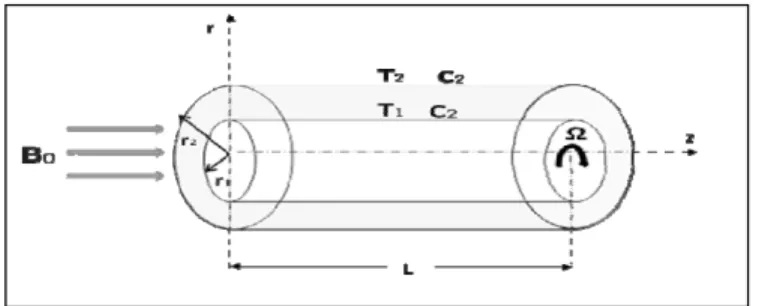
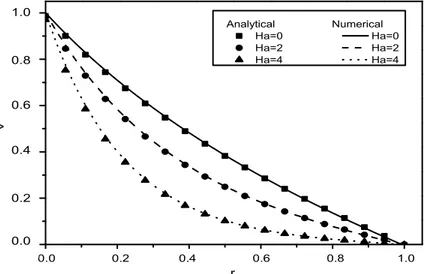
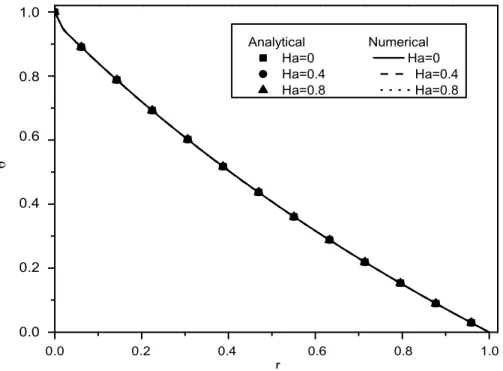

Documents relatifs
Nous avons défini le système chimique comme l’association de la cérusite et du carbonate de zinc hydraté, les deux composés identifiés en XRD dans les collyres stratioticon..
En somme, si dans le système-monde McDonald's est toujours un symbole de modernité américaine, dans le système national, il est avant tout le symbole du succès
Suivi et évaluation de la mise en œuvre des mesures contenues dans les plans de gestions environnementales et sociales (PGES) des carrières d’Elat et d’Eloumden I.. (Région
Average level of SNAP25 isoform mRNA expression in prefrontal cortex of individuals affected with bipolar disorder and unaffected controls, according to SNP4 genotypes. AA and
More specifically, the effects of the parameters; Reynolds number, angular velocity of the rotating cylinders W, ratios of the angular velocities of the two cylinders
The effect of a uniform external magnetic field on the criterion for the onset of thermal convection in an electrically conducting nanofluid saturated a Darcy-Brinkman porous
An additional overhead screen reduces radiative heat flux and also changes the airflow inside the incubator in such a way that the heat losses due to convection are smaller
At low values of the Taylor number, the heat transfer coefficient on the rotor increases strongly with rotation, probably by destruction of the boundary layer. The rotation
